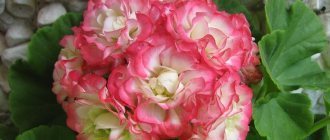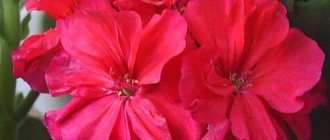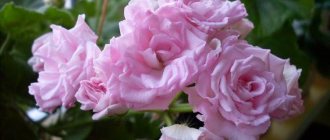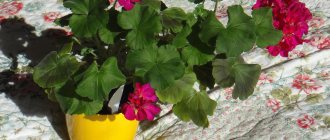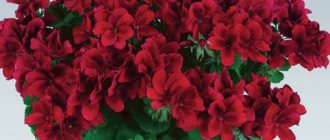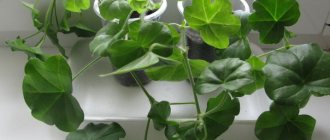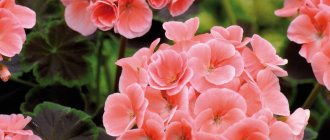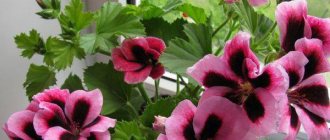History of origin
Botanists still cannot explain how yellow pelargoniums appeared in nature.
Many are inclined to believe that the yellow flowering, unusual for this plant, was the result of mutations. Others argue that it is the result of genetic engineering.
Natural pigments contained in pelargonium flowers are anthocyanins , they give purple and bright pink shades.
For this reason, breeders have encountered serious difficulties in developing yellow-flowering varieties. Whether it is a creation of nature, thanks to mutations, or of human hands, one way or another solar pelargonium exists and carries a yellow gene, which is always “linked” to the gene responsible for increased leaf rigidity. Therefore, the outlines of the bush of this plant are not the most beautiful if it is not refined.
The birthplace of pelargoniums is the African continent.
Origin story
The secret of the appearance of yellow pelargonium in nature is unknown. Perhaps this flower color appeared as a result of a mutation.
Or maybe someone once brought one or two branches of yellow pelargonium to Europe from the Dark Continent (in Latin it is called Pelargonium articulatum, or jointed Pelargonium), and since then it has been known only to a narrow circle of lovers and connoisseurs.
At least in retail flower shops, yellow pelargonium is not easy to buy. But, one way or another, it exists and is cultivated.
On a note. Difficulties in obtaining yellow color are explained by the fact that the main natural pigments of pelargonium are anthocyanins, shades of bright pink and purple.
They are antagonists of carotenoids and flavones, which are involved in the color of geranium in very small quantities.
Pelargonium articulated has a yellow gene , but at the same time it has very hard leaves and not the most beautiful bush outlines.
Additional efforts of breeders, the leaders of which are the English and “Van Meuwen”, are directed towards improving these characteristics.
Botanical description
Pelargonium yellow belongs to the geranium species . This plant is a perennial subshrub. Belongs to the species zonal pelargoniums.
The main feature of pelargonium species is the disproportionate arrangement of flower petals. The three lower petals are always smaller than the two upper ones.
Pelargonium species are exclusively indoor plants . They will not survive the winter in the garden, unlike geraniums, some species of which survive the winter well in flower beds.
What does geranium look like?
Readers are interested in knowing a description of what geraniums look like. This is an annual herbaceous plant about 50 cm high. It is distinguished by bright green leaves. They are large and have a pleasant lemon scent. They have a peculiar pattern in the form of a white border. Some varieties of geranium have double and darker leaves. This may mean that the variety is elite. The geranium seed is large.
The plant blooms at different times. Flowers can have all kinds of colors. Some varieties have no smell. Fragrant geraniums emit a very pleasant smell, refreshing the room. The flowers of pelargonium Silk swan, Samobor geranium, and Gourmet geranium are especially beautiful.
Common varieties: photos and descriptions
FirstYelloy
A variety with lush double yellow flowers, their diameter is 2-3 cm.
Guernsey Flair
The flowers are medium-sized, light lemon, the bush turns out to be lush, as the stems produce many branches .
Buttermilk
A popular variety with leaves that look like green velvet and creamy yellow flowers.
Creamery
This variety has the most lush inflorescence, consisting of light cream narrow flowers.
Pelargonia pulverulentum Oribi Flats and Pelargonia gibbosum
Their pale lemon- colored blooms are similar to those of snapdragons . It is not abundant; 3-5 inflorescences appear on the stems, which quickly fade.
First yellow pelargonium
First Yellow
At the Flowers 2009 exhibition, pelargonium lovers were pleased with the appearance of the first yellow pelargonium “First Yellow” from, which purchased it from. It is known that work on this variety took 20 years, and other yellow varieties are on the way.
Pelargonium " First Yellow" is a compact creamy yellow semi-double variety of zonal pelargonium with rich green leaves without a zone characteristic of this species. Propagated by cuttings, not by seeds. In industrial cultivation there is little need for growth regulators.
The origin of the variety is hidden in mystery - either it is genetically engineered, or it was obtained through conventional hybridization with yellow South African pelargoniums. If the second statement is true, then there must be a parent with yellow flowers. Is there such a contender?
All zonal pelargoniums are hybrids obtained from crossing two species - Pelargonium zonale and Pelargonium inquinans. They got their name for the presence of characteristic stripes on the leaves, although today there are many varieties without them.
Pelargonium articulatum - inflorescence
In South Africa, there is a species of articulated pelargonium (Pelargonium articulatum), a low plant with pale yellow flowers and a rhizome consisting of thick and thin sections, for which it probably received its species name. It is characterized by early senescence of leaves, which become quite unattractive at the time the plant blooms. Flowering cannot be called abundant - from 2 to 5 flowers are formed on several stems, and the flowering season is short. The plant is not very attractive for cultivation in pots - long petioles and drooping leaf blades are a poor decoration. But for hybridization, in addition to the unusual color of the flowers, there are other useful signs - short internodes, promising compactness, and light aromaticity of the leaves.
Pelargonium articulatum - leaves
This species has been used in Australia for interspecific hybridization through controlled cross-pollination. The first crossing of zonal pelargonium with articulated pelargonium was made in 1985. Pollen from an African plant was used on the paternal side. The main intrigue that everyone was interested in was whether the hybrids would have yellow flowers?
First Zonarctic hybrid
The first born was born in 1986 and had simple white flowers with reddish markings on the upper petals. The plant's habit was something between the parents. But the very fact of the possibility of crossing was a significant result. Subsequently, many hybrid seedlings were obtained, all of them different from each other.
A year later, it was possible to obtain several hybrids that had pale yellow flowers, but this color remained stable for only a few days. Only since 1993 have there been positive trends. In 1994, a hybrid was obtained that had 80% of the genome of articulated pelargonium and had semi-double pale yellow flowers of 9-11 petals, but it turned out to be too tall and irregular in shape. However, it showed that the yellow color of flowers can be inherited. We took 3 varieties as a starting point – “Lara Purnal”, “Princess Fiat” and “Millfield Gem”. As a result, two promising seedlings were obtained from these parents - “Lara Classic” and “Lara Polka”, and later “Lara Signal”, which were further pollinated with pollen of articulated pelargonium. In 1985, the self-explanatory “hybrid” name “Zonarctic” was coined, to which the prefix “Lara” was added on behalf of the breeder. Note that to obtain the “Lara Zonarctic Hybrid” line, pelargonium articulated was used 6 times both as a father and as a mother plant.
Semi-yellow Zonarctic pelargonium 1993
Subsequently, seedlings were selected that had at least 65% of the genome from Pelargonium articulatum, which turned out to be necessary for maintaining the yellow color and, at the same time, the most compact and symmetrical in shape. So there is material for interspecific hybridization.
One of the last Zonarctic seedlings
Another possible way to obtain yellow pelargonium is genetic engineering. It is known that the color of flowers of any plants is determined by pigments related to phenolic compounds: anthocyanins give colors from orange and red to blue and violet; flavones color plant tissues yellow and cream tones. The combined presence of anthocyanins and flavones gives a variety of color shades. Pelargonium gives its name to the red pigment - pelargonidin, which predominates in the color of zonal pelargoniums. It has been established that the yellow pigments of pelargonium are flavones and carotenoids.
The possibility of obtaining yellow pelargonium was of interest back in the 19th century, but it was impossible to do this using conventional methods, since in zonal pelargonium the color of flowers is determined by anthocyanins, and there are no pathways for the synthesis of flavones and there is no gene for yellow color. Genetic engineering methods allow you to introduce this gene from another plant.
Since it is not known whether this was done to obtain the yellow pelargonium “First Yellow”, we will give an example. Through biochemical studies, it was established that the color of snapdragon flowers is due to pigments called aurones. The genes responsible for the synthesis of yellow aurone, aureosidine glycoside, were identified and inserted into the genome of the torenia variety “Summerwave Blue” in order to obtain yellow flower color. However, endogenous anthocyanins, responsible for the blue color of torenia, remained dominant and did not allow yellow pigments to appear. To solve this problem, it was necessary to introduce another gene responsible for suppressing the synthesis of anthocyanins. As a result, it was possible to obtain yellow coloring of torenia flowers. A similar strategy could be used for pelargonium.
Guernsey Flair (Thompson & Morgan)
Buttermilk (Van Meuwen)
One way or another, yellow pelargonium is obtained. But is she the first? The English one also announced a breakthrough in floriculture - the world's first yellow zonal pelargonium " Guernsey Flair" with branched stems and medium-sized flowers, lemon-colored. Another contender for the championship is pelargonium “Buttermilk” (“Curdled milk”), creamy yellow in color with velvety green foliage, from another English one. Pelargonium “Guernsey Flair” has the same face, and, as they say, is not yellow at all, but rather creamy.
Since the origin of all three new products is unknown, only one thing is clear: if these are not miracles of genetic engineering, then, most likely, “chickens” from the same incubator - Australian.
The article uses materials from the site
www.geraniaceae-group.org/developing_zonartic.html _ _
Choosing a location and landing features
Location and lighting
The plant will do well on east and south windows. It is imperative to protect it from direct sunlight with a curtain, otherwise the leaves will burn. Pelargonium can be placed not on the windowsill itself, but not far from it, but so that the lighting from the window is still good.
Yellow pelargonium does not tolerate close proximity to other plants. Therefore, the pot with it should be kept at a distance so that the leaves do not come into contact with the leaves of other indoor flowers.
Pot
The best option would be deep, but not wide. In a very wide pot, pelargonium will not bloom so profusely .
The soil
Remember that pelargoniums grow naturally in Africa, so this plant does not need very nutritious soil. A mixture of garden soil, sand and peat in equal proportions would be ideal. At the bottom, drainage from expanded clay or crushed brick is required. You can also purchase special soil for pelargoniums.
If the soil is taken from the street, it must be calcined in the oven for at least an hour to kill all microbes. Neglecting this advice can lead to the rapid death of such a rare flower.
Transfer
You cannot replant a flowering plant after purchase, even if the soil in which it is located seems poor. It is necessary to wait until the end of flowering, only then will the transplant be successful.
Pelargoniums are replanted in the spring . If the flower was purchased at another time of the year, there is no need to replant until spring.
The flower is removed from the old pot along with a lump of earth. You cannot shake out the roots from the soil and wash them.
Drainage is laid out at the bottom, then soil is poured, pelargonium is placed and sprinkled with earth on all sides. Then you need to water a little.
How to plant?
The conditions for pelargoniums with cream and pale yellow flowers are no different from the conditions for pelargoniums of other colors. The plant is quite unpretentious for gardeners, but must be kept indoors.
Pelargonium prefers warmth and light, but you should avoid direct sunlight.
Attention! The flower loves freedom and does not feel very good in close proximity to other plants.
It is better to choose a pot for pelargonium that is not very wide. In a wide pot the plant will not bloom as profusely. Watering should be moderate, because waterlogging affects the condition of the plant worse than lack of water.
Lighting and location
Pelargonium feels good on eastern and even southern windows, but in indoor conditions it is better to shade it from direct rays of the sun.
Some types of pelargonium prefer medium lighting, and for them it is better to choose a place near the window, but not on the windowsill itself.
Soil requirements
The soil should be slightly acidic, consisting of equal parts of peat, sand and garden soil. Pelargonium is an African plant that is not accustomed to very nutritious soil.
The pot must have good drainage. The soil should be loosened periodically.
Street soil must be calcined in the oven to destroy pests and their larvae, as well as pockets of possible infectious diseases.
There is no need to risk the health of the flower and save on land; soil for pelargoniums is available in many supermarkets and is inexpensive.
Plant care
Watering
The plant does not tolerate waterlogging very well . For pelargonium, a few days of drought are better than constant heavy watering. Therefore, you need to water when the soil in the pot becomes dry.
You can water only with filtered drinking water that has warmed to room temperature. If there is no such water, then you need to take it from the tap and leave it for at least a day so that the chlorine evaporates. If the rooms are cool in winter, you can slightly heat the water for irrigation so that it is not icy.
Yellow pelargonium cannot be sprayed! This will harm its downy leaves and flowers.
Top dressing
During the flowering period, to make it last longer, phosphorus-potassium fertilizers are used , which contain a low concentration of nitrogen. Liquid fertilizers can be used.
It is necessary to feed every week from May to September. In autumn and winter, the plant does not need feeding.
You cannot feed yellow pelargonium with organic fertilizers ; it will die from this. Only mineral ones are useful for her.
Topping
At the end of winter, the tips of the branches are pinched so that the bush takes on a beautiful shape and produces side shoots. Thanks to this, it will be lush.
Care
First of all, after purchasing a flower, you need to inspect it for withered leaves and insects hiding under them. For the flower you need to choose a well-lit, warm place without the scorching rays of the sun and drafts and, preferably, without other plants.
There is no need to replant flowering pelargonium immediately after purchase , even if the land in which it is currently located seems scarce to you.
Pelargonium does not like nutritious soil; it blooms poorly in such soil and does not tolerate excess water.
Pelargonium loves fresh air, so in summer, when the weather is warm, it is good to keep it on the balcony, where there is the possibility of shading.
If the plant does not bloom, then its replanting will most likely be successful. Once removed from the ground, the root does not need to be washed.
A little expanded clay or broken shards are poured into the bottom of the pot, then a layer of soil, then the plant is placed on the soil, sprinkled with earth, lightly compacted and watered.
Transplantation of yellow pelargonium is done in the spring. If a complete transplant is not possible, then the top layer of soil is replaced. The pot should be slightly wider than the root system.
In order for the bush to branch well, at the end of winter - beginning of spring you will have to pinch it, removing the growth zone. This will force the plant to throw out new side shoots, and a more luxuriant bush will form.
Yellow pelargonium should be watered sparingly; the flower tolerates drought more easily than waterlogged soil.
You cannot spray zonal pelargonium - during the flowering period this can have a bad effect on the flowers. Mineral or liquid fertilizers are good as feeding for growing pelargonium, and during the flowering period - phosphorus-potassium fertilizers with a small nitrogen content.
Fertilizing should be done weekly from May to September.
Note! Organic fertilizers cannot be used for pelargonium.
Possible pests and diseases
Fungal diseases . Overwatering can lead to Verticellium wilt. The fungus starts in the soil and then covers the plant. It is necessary to transplant the pelargonium into a new pot and establish a normal watering regime.- Late blight . Pelargonium can get late blight. Many gardeners advise to immediately get rid of such a plant, since it is impossible to cure this fungal disease. But in its early stages you can try to cure it with Previkur and Profit-Gold.
- A fatal disease for pelargonium is black leg . This is a fungus that attacks the roots; it is insensitive to fungicidal drugs.
- Fungal infections . If the leaves are covered with rust, this also indicates a fungal disease. Rust develops due to excessive watering and keeping in a room with high humidity. It is successfully treated with fungicides. Before this, all affected parts of the flower are removed.
- mites appear due to lack of watering and dry air in the room. You can get rid of them by purchasing a special preparation for flower growers at a flower shop.
- Whiteflies can appear on pelargonium ; these insects hide on the underside of the leaves. They give themselves away as sticky spots on the leaves. To destroy whiteflies, traps and karbofos are used.
- Aphids may appear on sunny pelargonium . These tiny insects sit on stems and leaves. Among the folk remedies, spraying with garlic tincture helps. But it’s still better to purchase a special insecticide.
A sick plant must be immediately isolated from others so that disease or insects do not affect all indoor flowers.
Features of caring for a rare beauty - yellow pelargonium
Yellow pelargonium is a rare indoor plant. Flower growers who managed to get this miracle for their home collection are very proud of it.
In ordinary flower shops, such a plant is very rare; it is easier to order it online. It is also known as sun geranium because of its yellow flowers. This sunshine will definitely decorate any home with its lush blooms.
History of origin
Many are inclined to believe that the yellow flowering, unusual for this plant, was the result of mutations. Others argue that it is the result of genetic engineering.
Natural pigments contained in pelargonium flowers are anthocyanins , they give purple and bright pink shades.
For this reason, breeders have encountered serious difficulties in developing yellow-flowering varieties. Whether it is a creation of nature, thanks to mutations, or of human hands, one way or another solar pelargonium exists and carries a yellow gene, which is always “linked” to the gene responsible for increased leaf rigidity. Therefore, the outlines of the bush of this plant are not the most beautiful if it is not refined.
The birthplace of pelargoniums is the African continent.
Botanical description
Pelargonium yellow belongs to the geranium species . This plant is a perennial subshrub. Belongs to the species zonal pelargoniums.
The main feature of pelargonium species is the disproportionate arrangement of flower petals. The three lower petals are always smaller than the two upper ones.
Pelargonium species are exclusively indoor plants . They will not survive the winter in the garden, unlike geraniums, some species of which survive the winter well in flower beds.
Appearance and features
The bushes are always erect with hard leaves. The stems are also erect and branched. The edges of the leaves are wavy, and their surface is covered with fluff. Yellow flowers are always collected in umbrella inflorescences.
Modern varieties have yellow blooms , there are no splashes of red on the petals.
Common varieties: photos and descriptions
FirstYelloy
A variety with lush double yellow flowers, their diameter is 2-3 cm.
Guernsey Flair
The flowers are medium-sized, light lemon, the bush turns out to be lush, as the stems produce many branches .
Buttermilk
A popular variety with leaves that look like green velvet and creamy yellow flowers.
Creamery
This variety has the most lush inflorescence, consisting of light cream narrow flowers.
Pelargonia pulverulentum Oribi Flats and Pelargonia gibbosum
Their pale lemon- colored blooms are similar to those of snapdragons . It is not abundant; 3-5 inflorescences appear on the stems, which quickly fade.
Choosing a location and landing features
Location and lighting
The plant will do well on east and south windows. It is imperative to protect it from direct sunlight with a curtain, otherwise the leaves will burn. Pelargonium can be placed not on the windowsill itself, but not far from it, but so that the lighting from the window is still good.
Pot
The best option would be deep, but not wide. In a very wide pot, pelargonium will not bloom so profusely .
The soil
Remember that pelargoniums grow naturally in Africa, so this plant does not need very nutritious soil. A mixture of garden soil, sand and peat in equal proportions would be ideal. At the bottom, drainage from expanded clay or crushed brick is required. You can also purchase special soil for pelargoniums.
If the soil is taken from the street, it must be calcined in the oven for at least an hour to kill all microbes. Neglecting this advice can lead to the rapid death of such a rare flower.
Transfer
You cannot replant a flowering plant after purchase, even if the soil in which it is located seems poor.
It is necessary to wait until the end of flowering, only then will the transplant be successful. Pelargoniums are replanted in the spring . If the flower was purchased at another time of the year, there is no need to replant until spring.
The flower is removed from the old pot along with a lump of earth. You cannot shake out the roots from the soil and wash them.
Drainage is laid out at the bottom, then soil is poured, pelargonium is placed and sprinkled with earth on all sides. Then you need to water a little.
Plant care
Watering
The plant does not tolerate waterlogging very well . For pelargonium, a few days of drought are better than constant heavy watering. Therefore, you need to water when the soil in the pot becomes dry.
You can water only with filtered drinking water that has warmed to room temperature. If there is no such water, then you need to take it from the tap and leave it for at least a day so that the chlorine evaporates. If the rooms are cool in winter, you can slightly heat the water for irrigation so that it is not icy.
Top dressing
During the flowering period, to make it last longer, phosphorus-potassium fertilizers are used , which contain a low concentration of nitrogen. Liquid fertilizers can be used.
It is necessary to feed every week from May to September. In autumn and winter, the plant does not need feeding.
You cannot feed yellow pelargonium with organic fertilizers ; it will die from this. Only mineral ones are useful for her.
Topping
At the end of winter, the tips of the branches are pinched so that the bush takes on a beautiful shape and produces side shoots. Thanks to this, it will be lush.
Possible pests and diseases
- Fungal diseases . Overwatering can lead to Verticellium wilt. The fungus starts in the soil and then covers the plant. It is necessary to transplant the pelargonium into a new pot and establish a normal watering regime.
- Late blight . Pelargonium can get late blight. Many gardeners advise to immediately get rid of such a plant, since it is impossible to cure this fungal disease. But in its early stages you can try to cure it with Previkur and Profit-Gold.
- A fatal disease for pelargonium is black leg . This is a fungus that attacks the roots; it is insensitive to fungicidal drugs.
- Fungal infections . If the leaves are covered with rust, this also indicates a fungal disease. Rust develops due to excessive watering and keeping in a room with high humidity. It is successfully treated with fungicides. Before this, all affected parts of the flower are removed.
- mites appear due to lack of watering and dry air in the room. You can get rid of them by purchasing a special preparation for flower growers at a flower shop.
- Whiteflies can appear on pelargonium ; these insects hide on the underside of the leaves. They give themselves away as sticky spots on the leaves. To destroy whiteflies, traps and karbofos are used.
- Aphids may appear on sunny pelargonium . These tiny insects sit on stems and leaves. Among the folk remedies, spraying with garlic tincture helps. But it’s still better to purchase a special insecticide.
Reproduction
Seeds
The advantage of this method is that strong and abundantly flowering plants grow. Seeds are sown in moist soil in the middle of winter and covered with film. When the sprouts hatch, they can be sprayed with a growth stimulator. You need to pick after 2 weeks, and after 8 weeks the plants are ready to be transplanted into permanent pots.
By cuttings
The advantage is that the cutting quickly takes root and begins to grow. To do this, you need to cut off a side shoot from the pelargonium, dry it a little and put water on it so that it grows roots. When they appear, you can plant them in a permanent pot.
Yellow pelargonium, although very rare, is unpretentious . If you follow all the simple rules for caring for it, the plant will delight you with its amazing flowering and help create comfort in your home.
If you find an error, please select a piece of text and press Ctrl+Enter.
Reproduction
Seeds
The advantage of this method is that strong and abundantly flowering plants grow. Seeds are sown in moist soil in the middle of winter and covered with film. When the sprouts hatch, they can be sprayed with a growth stimulator. You need to pick after 2 weeks, and after 8 weeks the plants are ready to be transplanted into permanent pots.
By cuttings
The advantage is that the cutting quickly takes root and begins to grow. To do this, you need to cut off a side shoot from the pelargonium, dry it a little and put water on it so that it grows roots. When they appear, you can plant them in a permanent pot.
What other varieties and species are pelargonium famous for? Read about pelargonium Silk, Angel, terry, rosebud, fragrant, Pak, garden, dwarf, ampelous.
Yellow pelargonium, although very rare, is unpretentious . If you follow all the simple rules for caring for it, the plant will delight you with its amazing flowering and help create comfort in your home.
Varieties of pelargonium and geranium
Lemon geranium
This is a variety of fragrant pelargonium. The plant is quite tall, with heart-shaped leaves with sharp tips. The name is given by the characteristic smell.
Important! With slight contact with the leaves (even if you kiss them), they release a healthy lemon scent, refreshing the air.
Lemon geranium grows up to 70 cm in height and 35 cm in width. Blooms infrequently. The leaves have a beautiful graceful shape and are framed in the form of lace. The shades of the leaves vary from light green to deep green. In some varieties, the leaves exhibit purple and burgundy shades.
The flowers are light, small, growing either alone or in inflorescences.
Lemon geranium loves a lot of sun. Its aroma improves sleep. The plant purifies the air, so it is recommended to place it in the kitchen. Geranium can be outdoors, in which case it must be protected from direct sunlight.
Do not place the plant near the air conditioner or near the radiator. Lemon geranium is afraid of drafts. The optimal air temperature is about 20 degrees. The plant needs regular watering (daily in summer).
Pelargonium Lara Harmony
This is one of the most common varieties of geranium. Pelargonium is unpretentious in care.
Interesting. Pelargonium Lara Harmoni flowers look like small roses.
Pelargonium lara harmony has a straight stem with developed roots. The leaves are round, palmate, dark green, with a bloody red or brown circle. They emit a minty smell. The leaves are covered with soft, fleecy hairs.
Pelargonium Harmony blooms for a long time: under favorable conditions - all spring and summer. If the lighting is good, then pelargonium Lara Harmoni can bloom in autumn and even winter. If the plant blooms year-round, it has small, pale flowers.
After flowering ends, seed pods appear. The plant can withstand frosts up to 28 degrees. Requires good watering and does not withstand drought. The soil should be slightly acidic. In order for the plant to bloom well, you need to add a little leaf soil.
Pelargonium requires lighting and space. In summer it needs to be watered every other day.
Pelargonium Lara Harmony
Yellow geranium
This is a rather rare plant. The bush has dense foliage. The stems are branched. The flowers are collected in umbellate inflorescences. The leaves are pubescent.
Yellow geranium loves light and warmth and requires a lot of space. At the same time, you need to avoid direct sunlight.
Note! This type of geranium does not grow well in close proximity to other plants. The optimal placement of yellow geranium is an eastern and southern window.
There are many varieties of yellow geranium. They vary in flower color: from pale yellow to rich, leaf color - from light green to dark green.
Yellow pelargonium does not need too nutritious soil. The pot needs to have drainage. The soil should be loosened periodically.
Field geranium
This is a herbaceous perennial plant with a rhizome and ground part up to 80 cm high. Wild field geranium is much lower. The lower leaves are pinnate, the upper ones are short. The stems are pubescent and have a pleasant spicy aroma. The flowers are mostly purple and blue. In decorative varieties they can be double.
Field geranium bushes take root well in the garden. Blooms for at least 2 months.
Note! The bush does not lose its decorative properties throughout the season. At the end of flowering in autumn, the leaves turn red, brownish-purple.
Geraniums can be dug up from a meadow or forest edge and planted in the garden. The soil should be fertile and moderately moist.
Geranium pink
It is an erect, branched and evergreen shrub. Reaches 1.3 m in height. The branches of rose geranium become woody over time. The leaves have small hairs and have a pleasant rose scent. They are shaped like a heart. The flower is five-petalled, placed in umbels. Each petal has crimson stripes. It blooms from late winter to early summer with a peak in spring.
Pink geranium is a heat-loving plant. Requires a little moisture. Feels good in a hanging basket or container. Pink geranium does not tolerate severe frosts.
Pelargonium Rococo
This is a spectacular and very beautiful variety of geranium. The flowers are very delicate and resemble roses. They are grouped into beautiful large inflorescences. The buds are large and lush. The petals of Rococo pelargonium have a delicate pink color. The foliage is pale green.
Pelargonium Rococo is an unpretentious plant. She loves sunlight very much; in shaded places it will not bloom profusely and beautifully. In order for geraniums to delight you with their flowers at home, the pot should be placed on a well-lit windowsill.
Geranium varieties
Description of pelargonium
There are more than 300 species of geranium in the world, and most of them grow wild in South Africa. However, some species grow on our windowsill, in boxes on the balcony, in the garden, the diversity of which we can admire all summer long.
Field geranium
What does geranium look like? They have fragile and long stems that become woody over time. With good care they bloom profusely. Their leaves are shiny and relatively durable.
Geranium has spread well in recent decades. The choice of color shades is no longer limited to pink, white or red. Now these are bright combinations. The leaves are also varied, with different shades.
Pink geranium flower
Multi-colored and fragrant geraniums will bring beauty and benefit to your home. The aromatic leaves contain essential oils and smell wonderful. Their aroma repels mosquitoes. Flavored leaves can be successfully used in cooking: added to jam or jelly, replacing lemon zest. Placed in cake dough, can be used to produce medicinal syrups.
Varieties
Balcony pelargoniums are available in many varieties derived from crossing species, including a very large number of cultivars. Geraniums can be divided into four main groups:
- zonal geraniums;
- scented geraniums;
- large-flowered;
- ivy-shaped.
The most famous are the Zonale hybrid, popularly known as simple geranium. The round stems are woody, in the form of a small bush 35 cm high. The leaves have a darker arched pattern. The flowers are large, simple or full: red, pink, purple or white. Blooms from April to October.
The second group are geraniums with aromatic foliage, the smell of which can be reminiscent of rose, pine, lemon or mint. Their popularity has increased in recent years.
Pelargonium lemon
Geranium, with its aromatic leaves, is little known and is commonly grown as a houseplant. However, they are often hardy enough to grow in the garden during summer days. The aromas of these geraniums differ depending on the type. Pelargonium graveolens has a pleasantly fresh lemon aroma. There are geraniums whose leaves smell like roses, have the scent of apple, mint, eucalyptus, or have a sweet-spicy scent.
Pelargonium fragrant Gourmet
Pelargonium fragrant odorata Orange
Lemon scented geraniums were developed in Europe in the late 18th century through natural crossing and then improved through selection. The aromatic plant has a very pronounced lemon aroma. Lemon geranium is grown in tropical areas to produce an essential oil used in perfumes, insect repellents, and the food industry.
